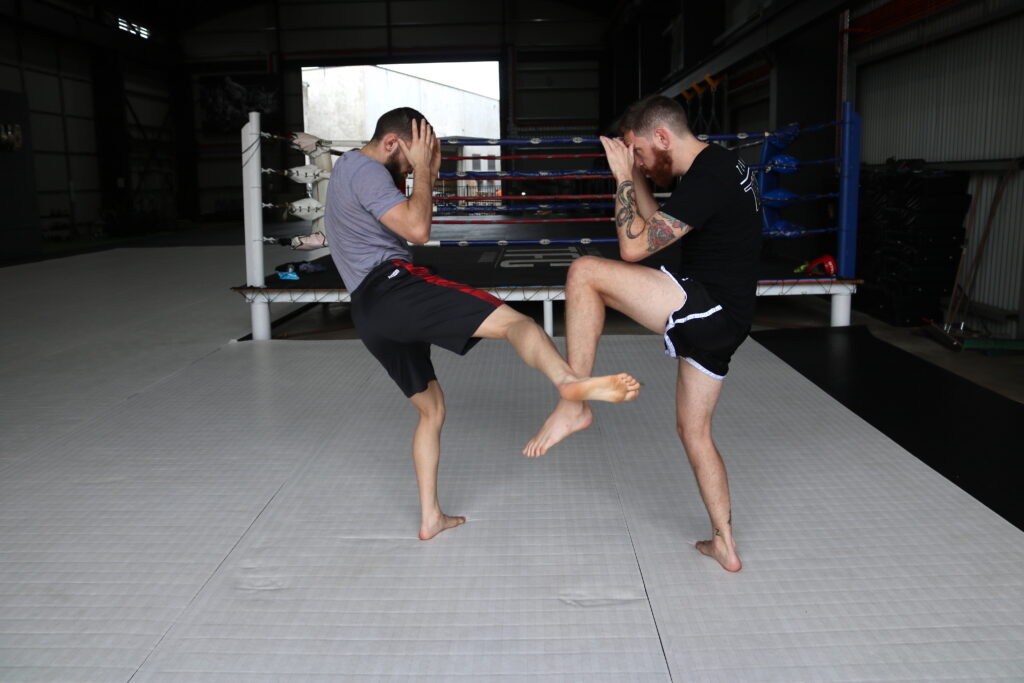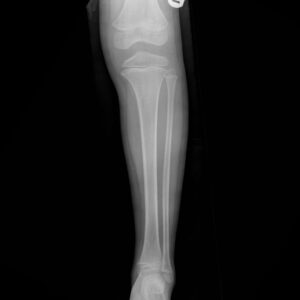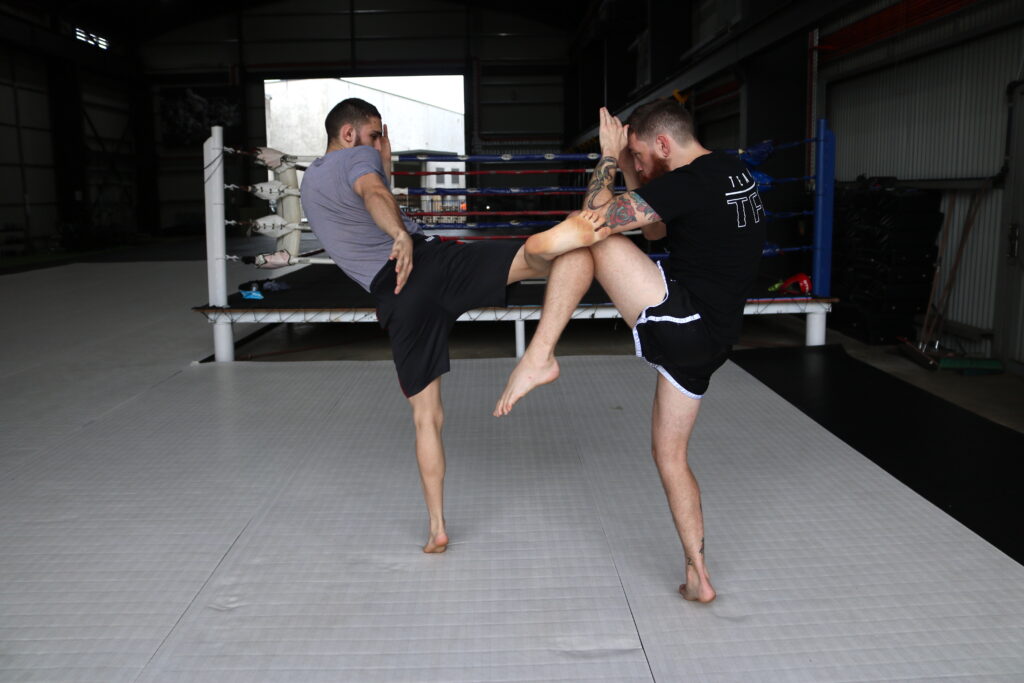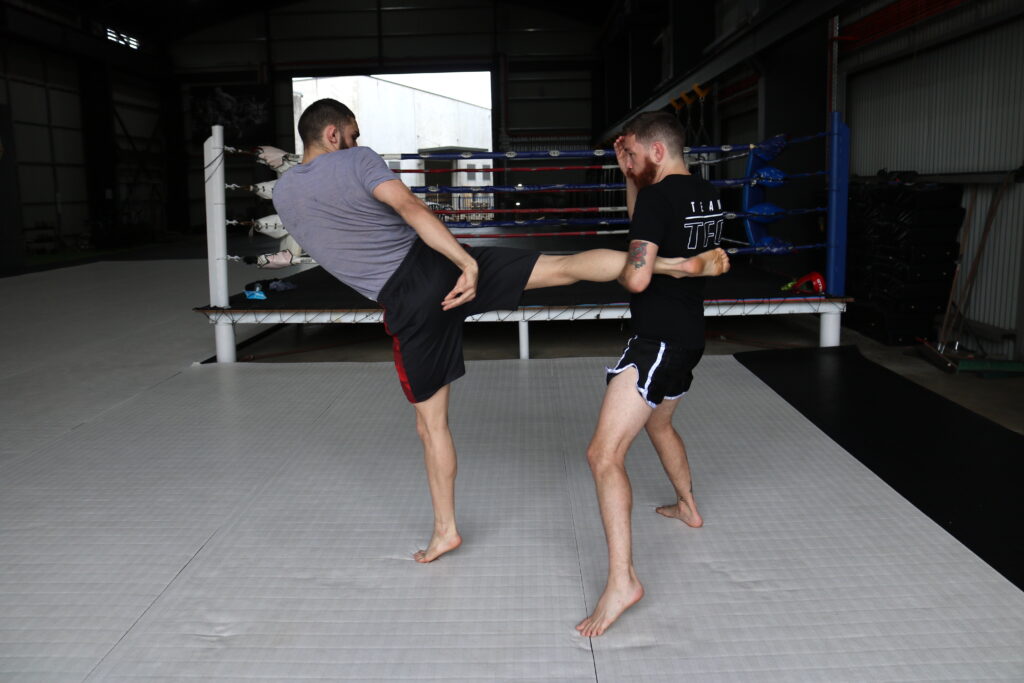Upcoming Events
No event available, please check back again, thank you.
Latest Articles
How to Block a Muay Thai Kick: Check, Catch, and Return Kicks
28 October 2022
Kicking is one of the most exciting parts of learning Muay Thai. You learn to control your body weight and keep your balance even as your centre of gravity shifts around. You also practise many different ways to kick, and as you train, build a lot of leg power for stronger kicks. That said, you won’t be kicking all the time in Muay Thai. There will be times when you will be on the receiving end. And in these cases, you’ll need to know how to block incoming Muay Thai kicks.
Martial arts, in general, is more than just dealing damage. It’s also about being able to take damage, minimize it, and take advantage of certain opportunities to strike back after receiving. In this article, you’ll learn how to block a kick, catch it, and strike back while your opponent is off-guard.
Catch Kick to Return Kick: Practicing Frequently Used Movement Combinations in a Muay Thai Fight
Written by Lauren
In Muay Thai training, practice and repetition are the keys to improving technique. However, you don’t only have to rely on practising during kickboxing classes to work on your technique. You can and should practice at home, as well.
While taking Muay Thai classes is a great way to learn, running through practice drills at home will give you a head start on your classes. Especially as a beginner, you’ll find that knowing how to block a Muay Thai kick will help you feel less awkward doing the movements in classes.
Repeating one combination multiple times makes you more comfortable going through the motions. Let’s take a look at a drill that you can do that covers several techniques commonly used in Muay Thai fights.
-
Movements used in catching and returning kicks
Ideally, you should be evasive enough to avoid taking any damage during a fight. There are times, however, when you have to take some hits to win. A good example of this is when you’re looking to set up a counter.
In such cases, knowing how to block a Muay Thai kick will be useful. Here are the movements you’ll need to practise when blocking and countering kicks:
- Checking
- Catching
- Punching while holding the opponent’s leg
- Countering with a kick of your own
Of course, before you go into practising them vigorously, you should know how to do them right. This will help avoid building muscle memory for the wrong movements.
-
How to check a kick
Checking is basically blocking an incoming kick using your shin (ideally the upper half). It involves raising your knee above the level of the kick and turning your leg so that your shin receives the force.
The shin bone (also known as the tibia) is thicker at the top and thinner at the bottom. Kicking involves hitting a target with the lower half of your shin. Can you imagine what happens when a thin lower shin hits a thick upper shin?
If you guessed that the kicking leg might break, you are absolutely correct. That’s why you also have to avoid getting checked when you’re the one doing the kicking.
So, how do you check a kick? Here are a few key points to remember:
- Twist your leg so your shin is pointing in the direction the kick is coming from.
- Raise your knee a bit above the approximate level of the incoming kick.
- Keep your shin perpendicular to the ground.
- If blocking a body kick, bring your elbow down to the level of your knee to make sure no kicks slip through the check.
-
How to catch a kick
Catching a kick may sound scary, and we’ll be honest here—it will hurt if you do it incorrectly. But if you do manage to get it correctly, it will immobilize your opponent enough to get at least one solid hit in.
What is the proper way to catch a kick? Here are a few pointers:
- Anticipate the kick! You have better chances of catching a kick when you see it coming.
- Step towards the same direction the kick is going. If the kick is coming from the left towards the right, take a step right to minimize the impact. (Don’t step towards the leg. Move away from it. Don’t intercept it; let it come to you. It’ll make contact either way.)
- At the same time, bring your arm up and around the leg, holding it firmly at your side.
-
Drill it down
Once you’ve got the movements down, we’re on to the next step—drilling it down. Drilling the combination will help you get more comfortable with the movements and build muscle memory.
Repetition creates mastery. Drills will help you polish your execution and how you transition between movements. This way, when it’s time for you to use it in a fight, it’ll be second nature, and you’ll be quick on your feet.
Here’s how the drill goes:
- Let your partner throw a kick.
- Check the kick, letting your knee and elbow overlap. At this point, your partner will pull their leg back to their fighting stance.
- When they kick for the second time, catch the leg.
- Hold on to the leg and throw a cross to the body, just below the sternum.
- Step back and push the leg towards the direction it was going before you caught it.
- As soon as you release, return the kick up high on the opponents body/arms/head.
Rinse and repeat. Make sure to swap roles with your partner so you both benefit from the drill!
Here’s a short video to make the drill easier to visualize:
Once you’re comfortable with the drills and it’s becoming to become monotonous, consider being a bit creative and switching things up. What else can you do with the leg when you catch it? Perhaps you can throw it back, or throw it the other way. Perhaps you can sweep the other leg and put your opponent in the ground.
Drilling is to make sure that you get the movements down, but that doesn’t mean you have to do the same thing forever. Stick with it for a bit, then change it up and stick with that one for a bit.
-
Final thoughts
Running through a drill will be awkward in the beginning, especially if you’re just starting Muay Thai training. However, the more you practice, the easier the transitions will become. You can adjust your pace, starting slowly as you familiarize yourself with the movements and transitions. Build up your pace as you improve your skills.
When practising at home, stick with one combination and then do it for a whole round. Then in the next round, change one thing and do that for a whole round. The more times you practice a drill, the more acclimated you’ll become to the multiple techniques.
Doing each drill multiple times increases your comfort and skill level with the transitions. Repetition is the key not just to developing technique and skill but also to building your confidence in the movement. After repetitive practice, those movements and transitions will start to come naturally.




